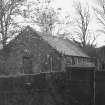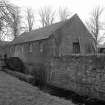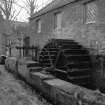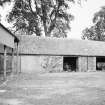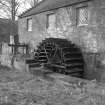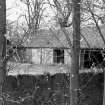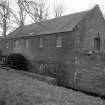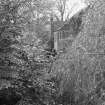Tyninghame House, Sawmill
Saw Mill (19th Century)
Site Name Tyninghame House, Sawmill
Classification Saw Mill (19th Century)
Alternative Name(s) Tyninghame Estate; Tyninghame House Policies; River Tyne
Canmore ID 122202
Site Number NT67NW 61
NGR NT 61116 78953
Datum OSGB36 - NGR
Permalink http://canmore.org.uk/site/122202
- Council East Lothian
- Parish Whitekirk And Tyninghame
- Former Region Lothian
- Former District East Lothian
- Former County East Lothian
NT67NW 61 61116 78953
For Tyninghame House (NT 61934 79840) and associated buildings, see NT67NW 3.00.
(Location cited as NT 611 790). Sawmill, Tyninghame, 19th century. An attractive single-storey 5-bay rubble building with crow-stepped gables and diamond-paned windows. The machinery is driven by a 6-spoke, low-breast wood and iron paddle wheel about 4ft (1.22m) wide by 14ft (4.27m) diameter.
J R Hume 1976.
Opposite the Factor's House is the crowstepped sawmill, built in 1828 by Thomas Hannan, mason, and the engineer George Sked.
J Gifford 1992.
Construction (1828)
Opposite the Factor's House is the crowstepped sawmill, built in 1828 by Thomas Hannan, mason, and the engineer George Sked.
J Gifford 1992.
Field Visit (1976)
(Location cited as NT 611 790). Sawmill, Tyninghame, 19th century. An attractive single-storey 5-bay rubble building with crow-stepped gables and diamond-paned windows. The machinery is driven by a 6-spoke, low-breast wood and iron paddle wheel about 4ft (1.22m) wide by 14ft (4.27m) diameter.
J R Hume 1976.
Publication Account (1985)
Whilst Cockburn was busy improving his estates and rebuilding the village at Ormiston, Thomas Hamilton, sixth Earl of Haddington, was equally immersed in agricultural experimentation, notably in forestry. He planted Tyninghame and Binning Woods which are still prominent landscape features. It was a later generation, however, a century on, that built the estate village-still a very model of its kind, though gradually changing hands.
The harled factors house, c 1800, stands on the east side of the A 198, as do the lodge and arched gateway to the main house, c 1830. The estate sawmill opposite, now converted to a private house, was built in 1828 by Thomas Hannan, mason, and George Sked, engineer. It is an attractive, single-storey building with diamond-paned windows and crow-stepped gables. The machinery was driven by a six-spoke undershot (more accurately, low breast-shot wheel) of wood and iron, some 4.3 m in diameter by 1.2 m wide.
The main part of the village, on the side road, is largely 19th century, mostly by the same Thomas Hannan. Of rose-pink sandstone, the houses blend in varied relationships with each other and with the line of the road-a little clinical perhaps, but attractively so! The restored village pump, encased in wood, stands below the smiddy-note the windows-near to the Post Office.
'Tyninghame' signifies the farm on the river Tyne; it is one of three names in south-east Scotland (also Whittinghame, Coldingham) that reflect the earliest stratum of Anglian (Northumbrian) settlement. And within the grounds of Tyninghame House stand the remains of the old parish church ofSt Baldred (NT 619796), an anchorite who died in AD 756 or 757. The 9th century monastery on the site was sacked by the later, Anglo-Danish Northumbrians in AD 941; the mid 12th century parish church remained intact until the old village was 'cleared' in 1761. The surviving Norman carving on the arches to its chancel and apse suggest, however, a church at least as spectacular as that at Dalmeny (no. 65).
Information from 'Exploring Scotland's Heritage: Lothian and Borders', (1985).

















